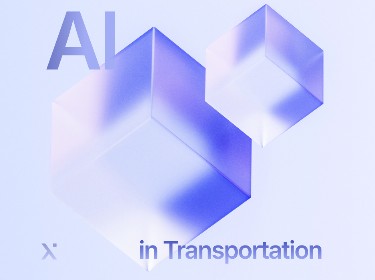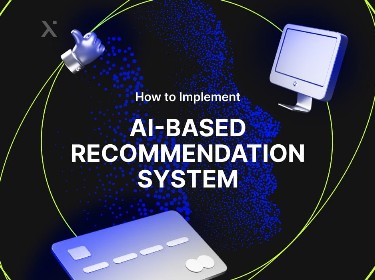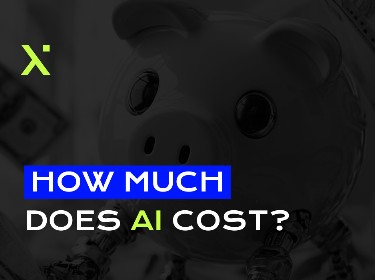With federated learning, a multitude of diverse devices and systems collaboratively contribute to a unified learning process. This significantly enhances model robustness and data privacy, without necessitating the centralization or disclosure of sensitive information.
Federated learning introduces an advanced approach to constructing machine learning models with a strong emphasis on data privacy.
This novel concept is rapidly gaining traction among businesses from various domains globally, as evidenced by its market size projection, which is set to expand from $128.3 million in 2023 to $260.5 million by 2030.
But what sets federated learning apart and why is it gaining such prominence?
Read on to find out more about federated learning, its working principles, and key advantages, and see where and how it can be applied.
Let’s start!
What is federated learning and how does it work?
Federated learning is a machine learning technique where algorithm training occurs across multiple decentralized devices or servers, each with its own local data samples.
Federated learning holds importance due to its capacity to leverage a wide array of data sources without the need to centralize data, thus respecting user privacy and adhering to data locality regulations.
Thanks to this, organizations are able to utilize the collective intelligence of data from various sources while mitigating risks associated with data centralization, such as security breaches and misuse.
How does federated learning work?
The federated learning process involves a central server sending an initial model to the devices, which then independently update the model using their local data. These devices send back only the model updates to the central server that aggregates these updates to refine the model.
The cycle repeats until the model achieves the desired accuracy. This iterative process allows for continuous improvement of the model, as it learns from a broad spectrum of data points, thereby enriching its accuracy and reliability over time without compromising data privacy.
What is the difference between machine learning and federated machine learning?
Federated learning differs from traditional centralized machine learning in that it does not require the collection of all data in a single location. Instead, it allows for the training of models on diverse data sets while maintaining data privacy and reducing the need for extensive data transfer.
By doing so, federated learning not only ensures compliance with privacy laws and reduces the risk of data breaches, but it also allows for the creation of more robust models that benefit from a broader and more varied dataset, which is often not possible in a centralized framework.
Get expert AI development in deep learning, machine learning, NLP, and computer vision. Contact us for a consultation to boost your business edge
What are the main benefits of federated learning?
![]()
Federated machine learning offers numerous substantial benefits, including enhanced user privacy and protection, adherence to regulatory compliance, improved accuracy and diversity in models, increased bandwidth efficiency, and greater scalability.
Let’s explore each of these advantages in greater detail.
Enhanced user data privacy protection
Federated learning ensures that data remains on the user’s device. This helps minimize the exposure of sensitive information, grants users increased control over their personal information, and reduces the likelihood of data breaches.
Adherence to regulatory compliance
By avoiding the centralization of data, federated learning helps businesses comply more easily with data protection laws like the General Data Protection Regulation (GDPR). This is particularly essential for international operations where data transfer across borders can be legally complex and fraught with compliance risks.
Improved model accuracy and diversity
By tapping into a variety of data sources, federated learning assists in developing models that are accurate and representative of diverse datasets. It also enables the incorporation of real-world data variations, which enhances the robustness and generalizability of machine learning models.
What’s more, federated machine learning allows for the inclusion of underrepresented data segments and boosts the fairness and inclusivity of ML applications.
Increased bandwidth efficiency
One of the greatest advantages of federated learning is that it reduces the need for large-scale data transfers between clients and servers, which is essential in bandwidth-constrained environments or in cases where data transfer costs are a concern.
Chiefly, federated machine learning optimizes network usage, which can be a vital aspect for businesses operating with limited network resources.
Greater scalability capacity
Federated learning is adaptable to various devices and networks, from smartphones to IoT solutions, which makes it highly scalable.
With such a high level of flexibility and adaptability, businesses have the opportunity to implement machine learning solutions in a wider range of scenarios, from customer-facing applications to internal data processing, without being limited by any hardware constraints.
Take a look at how our AI/ML development team created this AI-powered IP protection platform that aids NFT creators and brands in safeguarding their intellectual property in web3
What are the key types of federated learning?
There are several types of federated learning, each catering to different data scenarios and business needs.
Below, we will take a closer look at horizontal, vertical, and transfer federated learning.
Horizontal federated learning
Horizontal federated learning is most suitable for businesses that have datasets with similar features but different samples. For example, multiple financial institutions may use HFL to collaboratively improve fraud detection models while keeping their customer data private and local.
Vertical federated learning
This type of federated learning is generally used in organizations that hold different types of data about the same set of individuals. An instance of this could be a partnership between a bank and a retail company, where they collaboratively enhance customer service or product recommendations without sharing sensitive customer data directly.
Transfer federated learning
Businesses can use this type of federated learning to transfer knowledge from one domain to another, which allows for more versatile and comprehensive model development across varied industries.
For example, a retail company can enhance its customer behavior predictions by incorporating insights from a healthcare provider’s patient data analysis, all without exchanging any actual data.
Find out more about machine learning as a service (MLaaS) and see why it is essential for business growth
What are the limitations and challenges of federated learning?
While offering significant advantages, federated learning also presents certain limitations that businesses must consider before embracing it.
Below, we will take a look at some of the most common challenges of federated learning and provide tips on how to deal with them.
Data heterogeneity
In federated learning, data is distributed across numerous devices, often leading to non-IID (independent and identically distributed) and unbalanced datasets. This heterogeneity can result in challenges in model training and performance and make it difficult to develop models that perform consistently across all devices.
To overcome this, techniques like advanced data sampling and model personalization can be employed to ensure more uniform model training and performance across diverse data sets.
Communication overhead
The iterative process of updating and aggregating models across multiple devices requires significant communication bandwidth. This can be a bottleneck, especially in environments with limited network resources.
Yet, optimizing communication protocols, such as using model compression techniques or updating models less frequently, can help reduce this overhead.
Computational constraints
Devices participating in federated learning, like smartphones or IoT devices, may have limited computational power, which can negatively impact the efficiency and speed of model training and updating.
Implementing adaptive algorithms that cater to the computational capacity of each device can mitigate this issue, and ensure smoother and more efficient model training.
Vulnerability to advanced cybersecurity threats
While federated learning is about preserving data privacy by default, it is still not immune to privacy risks. Sophisticated attacks like model inversion or differential attacks can potentially expose sensitive information.
To prevent this from happening, you can consider employing advanced data security services to boost encryption methods, differential privacy techniques, and mitigate the risks of privacy breaches.
Model and system complexity
Managing and scaling complex models across numerous devices is challenging. Plus, large-scale federated learning systems require efficient algorithms and robust infrastructure to handle the complexities of distributed model training.
However, utilizing more scalable and efficient machine learning algorithms, as well as advanced cloud-based infrastructures can aid in coping with these complexities.
Data quality
The quality and quantity of data on individual devices can vary, which might affect the overall federated machine learning model’s performance and its learning process.
Implementing strategies like data augmentation and synthetic data generation can enhance the quality and volume of training data and result in greater model accuracy and reliability.
Explore the essentials of building a robust AI/ML strategy and learn how to develop one for your business
Top 15 applications and use cases of federated learning across domains
![]()
The nature of federated learning is diverse, which is why it can be applied in a wide range of contexts.
Below, we present a list of the 15 most outstanding applications and use cases of federated learning across various sectors and directions.
1. Enhanced language models in mobile devices
Federated learning offers substantial benefits for predictive text and language modeling in smartphones and communication apps as it enhances the accuracy of language models by leveraging diverse user inputs across various devices. Crucially, federated learning does this without compromising the privacy of personal conversations.
On top of this, federated learning enables continuous improvement of models, as they can learn from new user inputs over time, thereby adapting to evolving language use and preferences. This results in more efficient and accurate predictive text capabilities and boosts the overall user experience in communication apps.
2. Customized experiences in digital applications
Federated machine learning allows mobile app development services to provide more personalized user experiences.
Taking music streaming services as an example, they can utilize federated learning to tailor playlists in accordance with individual preferences, which is achieved through local data analysis and conducted directly on users’ devices.
Thus, by implementing federated learning, developers can enhance user satisfaction by offering highly personalized playlists while maintaining a high level of data privacy. This ensures that personal listening habits are processed locally, and not transmitted to or stored on central servers, thereby protecting user data while still providing a tailored listening experience.
3. Data-driven insights in healthcare analytics
Federated learning is becoming increasingly important in the healthcare sector, especially in the realm of predictive analytics. A trusted custom healthcare software development company will help hospitals and medical institutions collaborate on disease prediction and treatment outcome analysis while maintaining strict adherence to health data privacy regulations.
Plus, the core advantage of federated learning in this direction is that it enables the sharing of insights and models derived from sensitive patient data without actually transferring the data itself. This ensures that patient records remain confidential and secure, yet allows for the pooling of medical knowledge and expertise across institutions.
Check out our blog guide to discover the top 20 examples of big data analytics applications in healthcare
4. Fraud prevention in financial services
A trusted financial software development company can help enhance fraud detection and prevention systems same as enables banks to collaboratively learn from transaction patterns across multiple institutions and improve the robustness of their existing ML fraud detection algorithms.
The unique aspect of federated learning is its ability to achieve this improvement without the need to share customer-specific data. This means that while banks are able to develop more effective methods to identify and prevent fraudulent activities, they simultaneously ensure the privacy of individual transactions.
Delve into the top 10 FinTech trends that are poised to shape the future of the industry
5. Intelligent energy management systems
The energy sector employs federated learning for smart energy management. By analyzing consumption patterns across various nodes in smart grids, utility companies can optimize energy distribution and forecast demand more accurately, all while keeping energy usage data decentralized.
As well as this, federated machine learning has the capability to bolster the efficiency of renewable energy integration into the grid and contribute to a more sustainable energy landscape.
6. Safety and efficiency in autonomous mobility
In the realm of autonomous vehicles and traffic management, federated learning contributes to safer and more efficient navigation systems.
By pooling insights from multiple vehicles and sensors, it enhances traffic flow and road safety algorithms, and promotes a safer transportation environment, all without sharing individual vehicle data.
7. Supply chain optimization
Companies seeking to implement cutting-edge supply chin development services and safeguard their data can opt for federated machine learning, too. This technology enables the analysis of data from various segments of the supply chain, which is instrumental in optimizing inventory levels and forecasting potential disruptions.
Plus, the most important aspect of federated learning in this application is its ability to aggregate insights from different supply chain stages without the necessity to centralize the operational data. This means companies can benefit from a comprehensive view of their supply chain dynamics and make informed decisions and keep their operational data decentralized and secure.
Take a look at our portfolio showcasing a range of successfully executed supply chain projects and solutions
8. Tailored learning in education
Educational institutions and EdTech companies may well consider leveraging federated learning algorithms in order to provide customized educational experiences.
Analyzing student performance and engagement data locally allows them to adapt learning content to individual needs, thus improving educational outcomes while safeguarding student privacy and promoting privacy-conscious educational environments.
Chiefly, federated machine learning can assist in identifying learning gaps and providing targeted interventions needed to contribute to the improvement and better acquisition of educational programs.
9. Predictive maintenance in manufacturing
In manufacturing, federated learning aids in predictive maintenance and quality control. Its algorithms are capable of processing data from machinery at different locations and enabling early detection of potential equipment failures.
Federated machine learning algorithms can also facilitate the optimization of production processes by identifying inefficiencies and predicting future performance trends, which results in more streamlined operations and greater product quality.
Learn how PixelPlex's specialized predictive analytics services and solutions can empower your business with data-driven decision-making and improve overall outcomes
10. Urban planning and safety in smart cities
With smart city initiatives gaining momentum, federated machine learning is emerging as a crucial technology for enhancing traffic management and public safety systems. It processes data from diverse urban sensors and cameras locally and helps authorities make data-driven decisions regarding traffic flow and emergency responses.
Thus, through federated learning, smart cities can achieve a delicate balance between advanced urban management and individual privacy.
11. Real-time environmental monitoring
Environmental agencies and researchers can rely on federated learning in order to perform real-time monitoring of environmental conditions like air quality, water quality, and soil health.
The advanced algorithms employed in federated learning can efficiently gather and analyze vast amounts of data from a distributed network of sensors spanning different locations. This sophisticated analysis not only identifies intricate patterns and changes in environmental conditions but also empowers swift responses to environmental hazards.
Find out how our team delivered this blockchain-powered radioactive and hazardous material management solution
12. Advancements in precision agriculture
The agriculture sector stands to benefit from federated learning, too, as the technology helps in precision farming by analyzing data from sensors and drones across different farms.
Federated machine learning also informs critical decisions related to planting, harvesting, and crop management, thus enhancing agricultural productivity and resource efficiency without the need for central data collection.
13. Personalization in eCommerce
eCommerce platforms can resort to federated learning to streamline customer shopping experiences. This technology analyzes user interaction data on local devices and empowers retailers to provide personalized product recommendations tailored to individual preferences.
What’s more, federated machine earning streamlines inventory management, which helps businesses better predict and manage stock levels.
AI in eCommerce: see how artificial intelligence can reshape the shopping landscape
14. More sophisticated cybersecurity measures
With the help of federated learning, organizations can continuously refine and fortify their cybersecurity measures, including security protocols and intrusion detection systems.
The federated machine learning technology also fosters swift adaptation to emerging threats, which makes it possible to establish a highly responsive and robust network security system that navigates the dynamic and constantly changing cybersecurity environment.
15. Enhanced pharmaceutical research
Pharmaceutical companies are also adopting federated learning to speed up the creation of new drugs and therapies via analyzing clinical trial data from multiple sources.
For researchers, the main advantage of federated machine learning is that it facilitates data analytics services and allows for data analysis without the need to share sensitive patient information. Thanks to this, researchers are able to tap into a more extensive and diverse dataset for their studies while respecting the privacy of clinical trial participants.
Not only ML: check out the top use cases of generative AI in healthcare, including drug discovery, personalized treatment, medical research, and more
Closing thoughts
Federated learning serves as a gateway to a future where privacy and efficiency coexist harmoniously. From healthcare to finance, this innovative technique is poised to redefine the way we handle sensitive data and make the dream of secure, decentralized data processing a reality.
At PixelPlex, we are genuinely excited about the possibilities that federated machine learning technology presents.
Our machine learning development company is ready to guide you through this evolving landscape and offer a comprehensive range of computer vision development and machine learning services, including:
- Consultation
- Custom software development services
- Software integration
- Model creation
This is your opportunity to revolutionize your workflows and embark on a path towards a smarter and more secure future — so don’t hesitate to contact us and take the first step toward harnessing the power of federated learning for your organization’s success.




